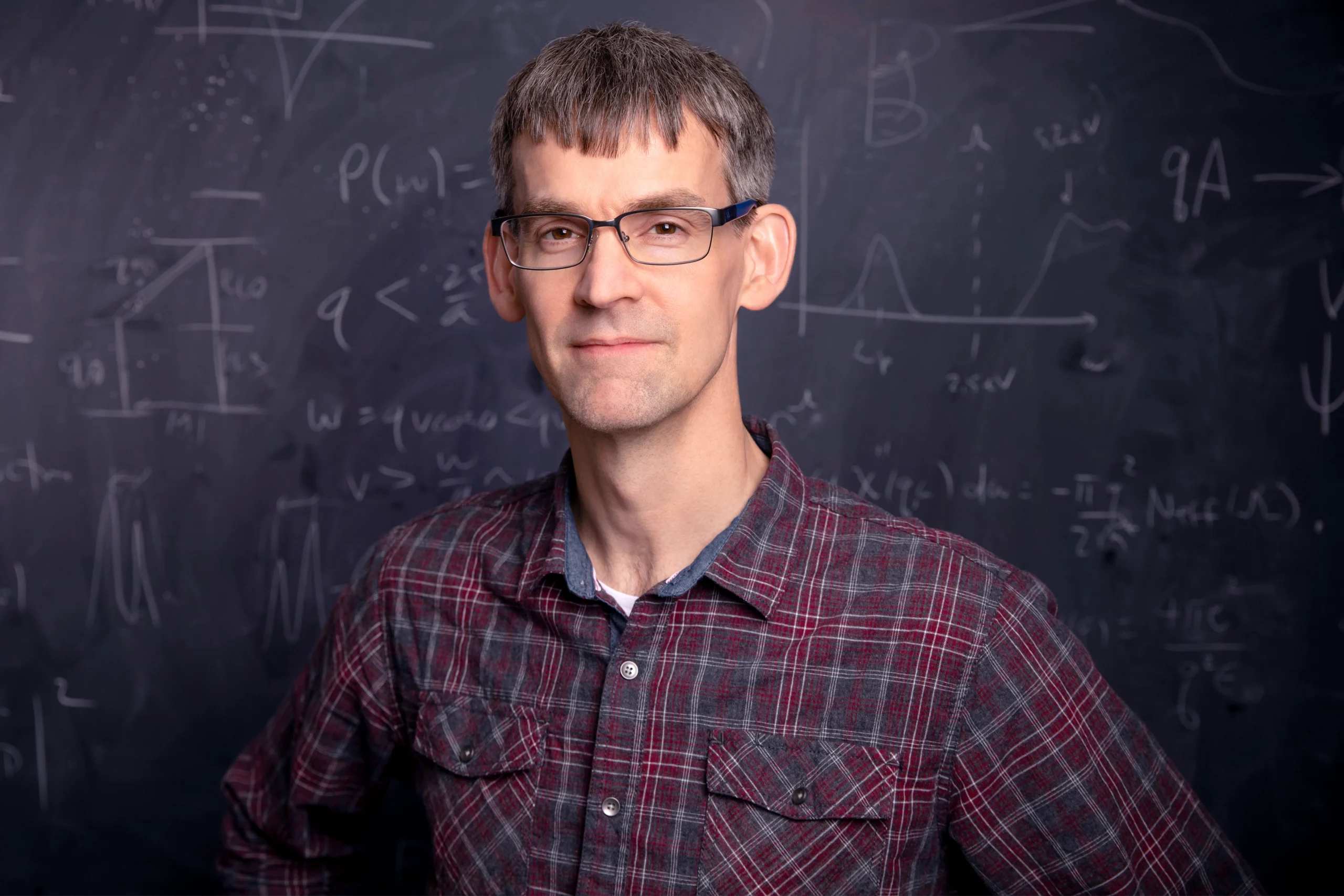Invisible ‘Demon’ Discovered in Odd Superconductor

Physicists have detected an unusual “demon” wave of electrons that is invisible to electromagnetic radiation.
Kristina Armitage/Quanta Magazine
Introduction
In 1956, David Pines formulated a phantom. He predicted the existence of seas of electric ripples that could neutralize each other, rendering the overall ocean motionless even as individual waves ebbed and flowed. The oddity, which came to be known as Pines’ demon, would be electrically neutral, and therefore invisible to light — the definition of tough to detect.
Over the decades, physicists managed to catch glimpses of demon variants. But Pines’ original demon — which would arise naturally out of electrons in metallic blocks — went undetected.
Now a team of physicists at the University of Illinois, Urbana-Champaign appears to have spotted Pines’ demon. After refining a technique for precisely tracking electrons as they ricochet off a material, the team produced and detected a series of periodic waves rippling through swarms of electrons. These waves, which physicists call “modes,” largely match Pines’ calculations. The researchers detailed their findings in Nature in August.
“These modes haven’t been seen for 70 years,” said Piers Coleman, a theoretical physicist at Rutgers University. But this new experiment, somehow, “picks up these demon modes.”
Imagine Demons
The 1950s were a boom time for studying electrons in metals. Physicists had already developed a simplistic theory that ignored electrons’ tendency to push each other away, treating them collectively as if they formed a sort of free-flowing gas. In 1952, Pines and his adviser, David Bohm, went a step further. After adding electron interactions to this “electron gas” theory, they found that electrons could bunch up in some places and spread out in others. These clustering electrons formed tidy waves of alternating higher and lower density (and therefore regions of higher and lower electric charge).
A wave of electrons (blue) with alternating regions of high and low density.
Merrill Sherman/Quanta Magazine
Pines then pushed the new theory further still. He imagined a material containing two gases, each made from a different type of charged particle. Specifically, he envisioned a metal with “heavy” electrons and “light” electrons. (All electrons are identical in theory, but in the real world their measurable properties depend on their environment.) Pines found that waves in the first gas could neutralize waves in the second; where heavy electrons bunched, light electrons would thin out. Then, as the heavy electron clusters dispersed, the lighter electrons would gather to fill in the thinner patches. Because one gas thickened precisely where the other gas thinned, the overall electron density of both types together — and therefore the overall charge and electric field — would remain neutral and unchanging. “Things can be moving even when they seem not to be,” said Anshul Kogar, a condensed matter physicist at the University of California, Los Angeles.
Overlapping waves of two types of electrons (blue and gold). The density of each color varies, but the overall density of particles stays the same everywhere.
Merrill Sherman/Quanta Magazine
Light reflects only from objects with an uneven distribution of electric charge, so the neutrality of Pines’ vibration rendered it perfectly invisible. Light comes in packets of energy called photons, and Pines christened the energy packets of his wave “demons.” The name was a nod to the demonic thought experiment of James Clerk Maxwell, a pioneering physicist who, Pines lamented, had lived too early to have a particle or wave named for him. “I suggest that, in honor of Maxwell, and because we deal here with a case of distinct electron motion (or D.E.M.), we call these new excitations ‘demons,’” Pines wrote in 1956.
Over the decades, physicists saw demonlike waves in various materials. In 1982, researchers at Bell Labs detected opposing waves in neighboring sheets of gallium arsenide. And this year, a team led by Feng Wang of the University of California, Berkeley described an experiment that captured near-invisible waves of electrons beating in synchrony with slightly thinner waves of positively charged particlelike objects in a sheet of graphene.

David Pines predicted that an invisible “demon” wave could arise in materials with two types of electrons.
Minesh Bacrania for SFI
But such sightings occurred largely in two-dimensional systems where a defining demonic feature was less striking. Due to a quirk in dimensionality, in 2D you can set off a charge wave with as little effort as you like. But in 3D, starting a wave requires a minimum amount of energy to get the asocial electrons to crowd together. The electrically neutral demons are spared this 3D energy fee. “Seeing the demon in a three-dimensional solid is a little bit special,” said Kogar, who did his doctoral research with the Urbana-Champaign group.
Here Be Demons
The Urbana-Champaign team, led by Peter Abbamonte, never went demon hunting. Pines’ demon walked straight into their lab.
In 2010, Abbamonte’s group began to develop a technique to detect fine tremors rippling through hordes of electrons. They would pelt a material with electrons and precisely record the energy they carried and the path they took when they bounced back. Based on the details of those ricochets, the group could infer how the material responded to the collision, which in turn revealed properties of any waves the collision created. It was a bit like determining whether a bathtub is filled with water, honey or ice by pelting it with pingpong balls.

Peter Abbamonte, a physicist at the University of Illinois, Urbana-Champaign, didn’t go looking for Pines’ demon. His group stumbled upon it while exploring a new way of studying materials.
University of Illinois
A few years ago, the researchers decided to put a superconducting metal called strontium ruthenate in their crosshairs. Its structure is similar to that of a mysterious class of copper-based “cuprate” superconductors, but it can be manufactured in a more pristine way. While the team didn’t learn the secrets of the cuprates, the material responded in a way that Ali Husain, who had refined the technique as part of his doctorate, didn’t understand.
Husain found that ricocheting electrons were sapped of their energy and momentum, which indicated that they were setting off energy-draining ripples in the strontium ruthenate. But the waves defied his expectations: They moved 100 times too quickly to be sound waves (which ripple through atomic nuclei) and 1,000 times too slowly to be charge waves spreading across the flat surface of the metal. They were also extremely low in energy.
“I thought it must be an artifact,” Husain said. So he put in other samples, tried other voltages, and even had different people take the measurements.
The unidentified vibrations remained. After doing the math, the group realized that the energies and momentums of the ripples fit closely with Pines’ theory. The group knew that in strontium ruthenate, electrons travel from atom to atom using one of three distinct channels. The team concluded that in two of these channels, the electrons were syncing up to neutralize each other’s motion, playing the roles of the “heavy” and “light” electrons in Pines’ original analysis. They had found a metal with the ability to host Pines’ demon.
“It’s stable in strontium ruthenate,” Abbamonte said. “It’s always there.”
The ripples don’t perfectly match Pines’ calculations. And Abbamonte and his colleagues can’t guarantee they aren’t seeing a different, more complicated vibration. But overall, other researchers say, the group makes a strong case that Pines’ demon has been caught.
“They have done all the good-faith checks that they can do,” said Sankar Das Sarma, a condensed matter theorist at the University of Maryland who has done pioneering work on demon vibrations.
Demons Unleashed
Now that researchers suspect the demon exists in real metals, some can’t help but wonder whether the motionless motions have any real-world effects. “They shouldn’t be rare, and they might do things,” Abbamonte said.
For instance, sound waves rippling through metallic lattices link electrons in a way that leads to superconductivity, and in 1981, a group of physicists suggested that demon vibrations could conjure superconductivity in a similar way. Abbamonte’s group originally picked strontium ruthenate for its unorthodox superconductivity. Perhaps the demon could be involved.
“Whether or not the demon plays a role is right now unknown,” Kogar said, “but it’s another particle in the game.” (Physicists often think of waves with certain properties as particles.)
But the main novelty of the research lies in spotting the long-anticipated metallic effect. To condensed matter theorists, the finding is a satisfying coda to a 70-year-old story.
“It’s an interesting postscript to the early history of the electron gas,” Coleman said.
And to Husain, who finished his degree in 2020 and now works at the company Quantinuum, the research suggests that metals and other materials are teeming with weird vibrations that physicists lack the instrumentation to understand.
“They’re just sitting there,” he said, “waiting to be discovered.”



